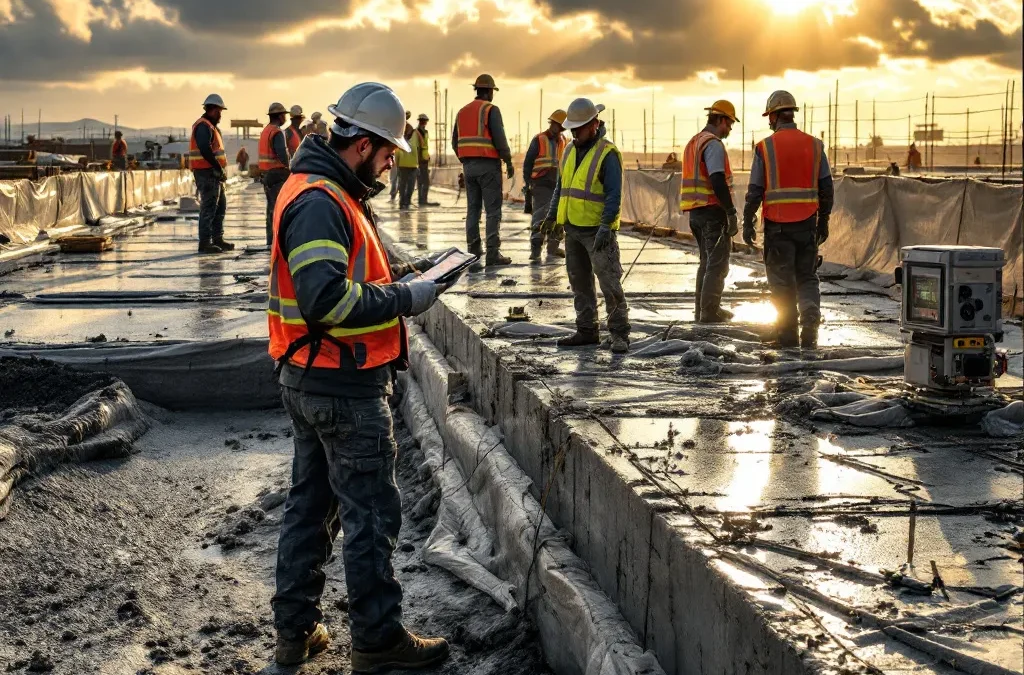Concrete is a critical material in the construction industry, especially for commercial projects. However, it is also highly sensitive to various environmental factors, making weather considerations paramount during concrete pours. Understanding how temperature, humidity, and other weather elements impact concrete can mean the difference between a successful project and costly repairs.
Understanding Concrete Composition
Concrete is composed of several fundamental elements: cement, aggregates, and water, each contributing to its overall properties. The mixture of these components results in a material that has unique characteristics that can be significantly affected by environmental conditions. For instance, both temperature and humidity can alter the curing process, affecting the final strength and durability of the concrete.
For more on how concrete installation works, read What to Expect During a Commercial Concrete Installation Project.
Effects of Temperature on Concrete Pours
Warm Weather
When the temperatures soar, the evaporation rate of water from the concrete mix increases dramatically. This can lead to rapid curing, which poses risks such as plastic shrinkage cracks that can compromise the integrity of the structure. To counteract these challenges, contractors can use retarders to slow the curing process or cover the concrete with wet burlap to maintain moisture and prevent cracks.
Learn how to avoid these issues by reading Top 7 Mistakes to Avoid in Commercial Concrete Construction.
Cold Weather
Cold temperatures present their own set of challenges, with the most severe being the risk of freezing. When concrete freezes before it has adequately cured, it can lead to delayed setting times and weakened structural integrity. To protect against these conditions, methods such as applying insulating blankets or incorporating accelerators into the mix can be effective solutions.
Understand the science behind proper curing by reviewing Understanding Curing Times for Commercial Concrete Projects.
Impact of Humidity Levels
High Humidity
High humidity levels can influence the curing times of concrete, often prolonging the finishing stage. The presence of moisture can also result in issues such as efflorescence, which is the formation of white, powdery deposits on the surface of concrete. To manage these complications, it is essential for contractors to monitor humidity levels closely and adjust their practices accordingly.
Choosing the right mix also helps reduce issues—read How to Choose the Right Concrete Mix for Your Commercial Project.
Low Humidity
Conversely, low humidity can increase the rate of evaporation, leading to surface drying and potential cracking issues. Implementing strategies such as erecting windbreaks to shield the work area or using surface curing agents can mitigate these risks effectively. These preventive measures are crucial for achieving a high-quality finish and structural integrity.
Wind and Rain Effects
Wind
Wind can significantly enhance evaporation rates, jeopardizing the curing process of freshly poured concrete. It is essential to recognize when wind conditions are unfavorable and take action to protect the fresh mix. Strategies such as windbreaks or temporary barriers can help reduce the wind’s impact, ensuring a more controlled curing environment.
Safety is key when working in these conditions. Check out Key Safety Measures for Commercial Concrete Pours.
Rain
Rain poses several risks when pouring concrete, particularly regarding washout and surface damage. If fresh concrete is exposed to heavy rainfall, it can lead to a compromised mixture and necessitate repairs. Best practices for pouring concrete during potential rain conditions include scheduling pours strategically and utilizing protective coverings like tarps to shield the concrete until it sets.
Seasonal Considerations for Concrete Projects
Seasonal weather patterns play a crucial role in planning concrete pours for commercial projects. Understanding the typical climate conditions during different months can help contractors choose the best times for specific applications. By aligning project schedules with favorable weather patterns, contractors can significantly improve the outcome of their concrete pours.
Also, explore insights in Differences Between Residential and Commercial Concrete Applications.
Weather Monitoring and Planning
Accurate weather monitoring is crucial for successful project management in concrete construction. Utilizing reliable weather forecasts aids in planning work schedules, allowing teams to prepare for and adapt to changing conditions. Several tools and technologies are available, such as mobile applications and on-site weather stations, which can provide real-time data to inform decision-making.
To boost profitability in project planning, check out A Contractor’s Guide to Bidding on Commercial Concrete Jobs Profitably.
Case Studies
Examining case studies of commercial concrete projects impacted by weather provides valuable insights into effective management strategies. Successful examples demonstrate how proactive measures can mitigate risks, while failures often highlight the consequences of neglecting weather conditions. Learning from these experiences empowers contractors to develop comprehensive approaches for better weather management during future projects.
Conclusion
Understanding how various weather conditions affect commercial concrete pours is essential for achieving successful outcomes. By considering temperature, humidity, wind, and rain risks, contractors can implement better strategies to protect their work. By planning ahead and adopting suitable measures, construction teams can ensure high-quality concrete results, regardless of the weather challenges they may face.
If weather complications have affected your commercial concrete pours—or if you want to avoid them altogether—call us at 916-562-2345 to speak with an expert and get a quote for your next project.


